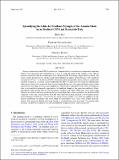| dc.contributor.author | Ma, Ding | |
| dc.contributor.author | Hassanzadeh, Pedram | |
| dc.contributor.author | Kuang, Zhiming | |
| dc.date.accessioned | 2017-11-14T17:47:59Z | |
| dc.date.issued | 2017 | |
| dc.identifier.citation | Ma, Ding, Pedram Hassanzadeh, and Zhiming Kuang. 2017. “Quantifying the Eddy–Jet Feedback Strength of the Annular Mode in an Idealized GCM and Reanalysis Data.” Journal of the Atmospheric Sciences 74 (2) (February): 393–407. doi:10.1175/jas-d-16-0157.1. | en_US |
| dc.identifier.issn | 0022-4928 | en_US |
| dc.identifier.uri | http://nrs.harvard.edu/urn-3:HUL.InstRepos:34353269 | |
| dc.description.abstract | A linear response function (LRF) that relates the temporal tendency of zonal-mean temperature and zonal wind to their anomalies and external forcing is used to accurately quantify the strength of the eddy–jet feedback associated with the annular mode in an idealized GCM. Following a simple feedback model, the results confirm the presence of a positive eddy–jet feedback in the annular mode dynamics, with a feedback strength of 0.137 day−1 in the idealized GCM. Statistical methods proposed by earlier studies to quantify the feedback strength are evaluated against results from the LRF. It is argued that the mean-state-independent eddy forcing reduces the accuracy of these statistical methods because of the quasi-oscillatory nature of the eddy forcing. Assuming the mean-state-independent eddy forcing is sufficiently weak at the low-frequency limit, a new method is proposed to approximate the feedback strength as the regression coefficient of low-pass-filtered eddy forcing onto the low-pass-filtered annular mode index. When time scales longer than 200 days are used for the low-pass filtering, the new method produces accurate results in the idealized GCM compared to the value calculated from the LRF. The estimated feedback strength in the southern annular mode converges to 0.121 day−1 in reanalysis data using the new method. This work also highlights the significant contribution of medium-scale waves, which have periods less than 2 days, to the annular mode dynamics. Such waves are filtered out if eddy forcing is calculated from daily mean data. The present study provides a framework to quantify the eddy–jet feedback strength in GCMs and reanalysis data. | en_US |
| dc.description.sponsorship | Earth and Planetary Sciences | en_US |
| dc.language.iso | en_US | en_US |
| dc.publisher | American Meteorological Society | en_US |
| dc.relation.isversionof | doi:10.1175/JAS-D-16-0157.1 | en_US |
| dash.license | LAA | |
| dc.subject | Annular mode | en_US |
| dc.subject | Eddies | en_US |
| dc.subject | Feedback | en_US |
| dc.subject | Jets | en_US |
| dc.subject | Climate models | en_US |
| dc.title | Quantifying the Eddy–Jet Feedback Strength of the Annular Mode in an Idealized GCM and Reanalysis Data | en_US |
| dc.type | Journal Article | en_US |
| dc.description.version | Version of Record | en_US |
| dc.relation.journal | Journal of the Atmospheric Sciences | en_US |
| dash.depositing.author | Kuang, Zhiming | |
| dc.date.available | 2017-11-14T17:47:59Z | |
| dc.identifier.doi | 10.1175/JAS-D-16-0157.1 | * |
| dash.contributor.affiliated | Ma, Ding | |
| dash.contributor.affiliated | Hassanzadeh, Pedram | |
| dash.contributor.affiliated | Kuang, Zhiming | |


